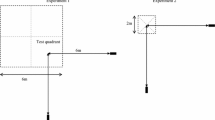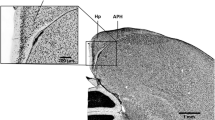Abstract
To analyze the navigational strategy of homing pigeons at familiar sites in view of a possible role of local landmarks, two groups of pigeons—one familiar to the release site, the other unfamiliar—were released with their internal clock shifted 6 h fast, with untreated birds of both groups serving as controls. The two groups showed median deflections of 67% and 57%, respectively, of the expected size, with no consistent difference in the size of the deflection between familiar and unfamiliar birds. This clearly shows that familiarity with the release site and with the local landscape features does not affect the size of the deflections induced by clock-shifting. Obviously, pigeons familiar with the release site do not change their navigational strategy, but still continue to determine their home course solely as a compass course. General problems with orientation by landmarks are discussed; however, landmarks may help birds to recognize a site and recall the respective course.




Similar content being viewed by others
Notes
When arguing in favor of landmark use, Wallraff et al. (1999) dismissed these findings by Füller et al. (1983) with the argument that the pigeons, having homed from the same site all summer, were ‘directionally trained’. However, this argument is inconsistent: if Wallraff et al. (1999) assume that birds extremely familiar with the route from the release site to their home loft, knowing every landmark intimately, prefer to fly compass courses over following sequences of landmarks, under what circumstances can they expect pigeons to rely on landmarks at all?
References
Balda RP, Turek RJ (1984) The cache-recovery system as an example of memory capabilities in Clark's nutcracker. In: Raitblat HL, Bever TG, Terrace HS (eds) Animal cognition. Erlbaum, Hilldale, NJ, pp 513–532
Batschelet E (1981) Circular statistics in biology. Academic, London, New York
Bingman VP, Ioalè P (1989) Initial orientation of anosmic homing pigeons based on information gathered at familiar release sites remains homeward directed following clock-shift. Behavior 110:205–218
Biro D, Guilford T, Dell'Omo G, Lipp HP (2002) How viewing of familiar landscape prior to release allows pigeons to home faster: evidence from GPS tracking. J Exp Biol 205:3833–3844
Biro D, Guilford T, Dawkins MS (2003) Mechanisms of visually mediated site recognition by the homing pigeon. Anim Behav 65:115–122
Biro D, Mead J, Guilford T (2004) Familiar route loyality implies visual pilotage in the homing pigeon. Proc Natl Acad Sci USA 101:17440–17443
Braithwaite VA (1993) When does previewing the landscape affect pigeon homing? Ethology 95:141–151
Braithwaite VA, Guilford T (1991) Viewing familiar landscapes affects pigeon homing. Proc R Soc Lond B 245:183–186
Braithwaite VA, Newman JA (1994) Exposure to familiar visual landmarks allows pigeons to home faster. Anim Behav 48:1482–14844
Burt T, Holland R, Guilford T (1997) Further evidence for visual landmark involvement in the pigeon's familiar area map. Anim Behav 53:1203–1209
Erichson JT, Hodos W, Evinger C, Bessette BB, Phillips SS (1989) Head orientation in pigeons: postural, locomotor, and visual determinants. Brain Behav Evol 93:268–278
Foa A, Albonetti E (1980) Does familiariry with the release site influence the initial orientation of homing pigeons? Experiments with clock-shifted birds. Z Tierpsychol 54:327–338
Füller E, Kowalski U, Wiltschko R (1983) Orientation of homing pigeons: compass orientation vs. piloting by familiar landmarks. J Comp Physiol 153:55–58
Gagliardo A, Ioalè P, Bingman VP (1999) Homing in pigeons: the role of hippocampal formation in the representation of landmarks used for navigation. J Neurosci 19:311–315
Gagliardo A, Odetti F, Ioalè P (2005) Factors reducing the expected deflection in initial orientation in clock-shifted homing pigeons. J Exp Biol 208:469–478
Graue LC (1963) The effect of phase shifts in the day–night cycle on pigeon homing at distances of less than one mile. Ohio J Sci 63:214–217
Griffin DR (1944) The sensory basis of bird navigation. Q Rev Biol 19:15–31
Griffin DR (1952) Bird navigation. Biol Rev Camb Phil Soc 27:359–400
Grüter M, Wiltschko R (1990) Pigeon homing: The effect of local experience on initial orientation and homing success. Ethology 84:239–255
Heinroth O, Heinroth K (1941) DasHeimfinde-Vermögen der Brieftauben. J Ornithol 89:213–256
Hodos W, Erichson JT (1990) Lower-field myopia in birds: an adaptation that keeps the ground in focus. Vis Res 30:653–657
Kamil AC, Cheng K (2001) Way-finding and landmarks: The multiple-bearings hypothesis. J Exp Biol 2043:103–113
Keeton WT (1974) The orientational and navigational basis of homing in birds. In: Advanced Study Behavior, vol 5. Academic, New York, San Francisco, London, pp 47–132
Keeton WT, Larkin TS, Windsor DM (1974) Normal fluctuations in the earth's magnetic field influence pigeon orientation. J Comp Physiol 95:95–103
Kowalski U, Wiltschko R (1987) Pigeon homing: familiarity with the release site reduces the release site bias. J Exp Biol 133:457–462
Kowalski U, Wiltschko R, Füller E (1988) Normal fluctuations of the geomagnetic field may affect initial orientation in pigeons. J Comp Physiol 163:593–600
Kramer G (1953) Wird die Sonnenhöhe bei der Heimfindeorientierung verwertet? J Ornithol 94:201–219
Kramer G (1957) Experiments on bird orientation and their interpretation. Ibis 99:196–227
Larkin TS, Keeton WT (1976) Bar magnets mask the effect of normal magnetic disturbance on pigeon orientation. J Comp Physiol 110:227–231
Lipp HP, Vyssotski AL, Wolfer DP, Renaudineau S, Savini M, Tröster G, Dell'Omo G (2004) Pigeon homing along highways and exits. Curr Biol 14:1239–1249
Luschi P, Dall'Antonia P (1993) Anosmic pigeons orient from familiar sites by relying on the map-and-compass mechanism. Anim Behav 46:1195–1203
Neuss M, Wallraff HG (1988) Orientation of displaced homing pigeons with shifted circadian clocks: predictions vs. observation. Naturwissenschaften 75:363–365
Papi F (1992) General aspects. In: Papi F (ed) Animal homing. Chapman and Hall, London, pp 1–18
Rivière BB (1923) Homing pigeons and pigeons racing. Br Birds 17:118–138
Schlichte HJ (1973) Untersuchungen über die Bedeutung optischer Parameter für das Heimkehr-Verhalten der Brieftauben. Z Tierpsychol 32:257–280
Schmidt-Koenig K (1961) Die Sonne als Kompaß im Heim-Orientierungssystem der Brieftauben. Z Tierpsychol 18:221–244
Schmidt-Koenig K (1979) Avian orientation and navigation. Academic, London, New York
Schmidt-Koenig K, Schlichte HJ (1972) Homing in pigeons with impaired vision. Proc Natl Acad Sci USA 69:2446–2447
Schmidt-Koenig K, Walcott C (1973) Flugwege und Verbleib von Brieftauben mit getrübten Haftschalen. Naturwissenschaften 60:108–109
Wallraff HG (1974) Das Navigationssystem der Vögel. Ein theoretischer Beitrag zur Analyse ungeklärter Orientierungsleistungen bei Vögeln. In: Schriftenreihe “Kybernetik”. R Oldenburg Verlag, München Wien
Wallraff HG, Kiepenheuer J, Streng A (1994) The role or visual familiarity with the landscape in pigeon homing. Ethology 97:1–25
Wallraff HG, Chappell J, Guilford T (1999) The role of the sun and the landscape in pigeon homing. J Exp Biol 202:2121–2126
Wiltschko R, Nehmzow U (2005) Simulating pigeon navigation. Anim Behav 69:813–826
Wiltschko R, Wiltschko W (1981) The development of sun compass orientation in young homing pigeons. Behav Ecol Sociobiol 9:135–141
Wiltschko R, Wiltschko W (2001) Clock-shift experiments with homing pigeons: A compromise between solar and magnetic information. Behav Ecol Sociobiol 49:393–400
Wiltschko R, Wiltschko W (2003) Avian navigation: from historical to modern concepts. Anim Behav 65:257–272
Wiltschko R, Nohr D, Wiltschko W (1981) Pigeons with a deficient sun compass use the magnetic compass. Science 214:343–345
Wiltschko R, Kumpfmüller R, Muth R, Wiltschko W (1994) Pigeon homing: the effect of a clock-shift is often smaller than predicted. Behav Ecol Sociobiol 35:63–73
Wiltschko W, Wiltschko R (1982) The role of outward journey information in the orientation of homing pigeons. In: Papi F, Wallraff HG (eds) Avian navigation. Springer Verlag, Berlin Heidelberg New York, pp 239–252
Wiltschko W, Wiltschko R, Keeton WT (1976) Effect of a “permanent clock-shift” on the orientation of young homing pigeons. Behav Ecol Sociobiol 1:229–243
Wiltschko W, Wiltschko R, Keeton WT, Madden R (1983) Growing up in an altered magnetic field affects the initial orientation of young homing pigeons. Behav Ecol Sociolbiol 12:135–142
Wiltschko W, Wiltschko R, Keeton WT (1984) Effect of a “permanent” clock-shift on the orientation of experienced homing pigeons. Behav Ecol Sociobiol 15:263–272
Acknowledgements
Our work was supported by the Deutsche Forschungsgemeinschaft (grant to R.W.). We sincerely thank S. Ratzel, M. Stahl, and P. Thalau for their valuable help with training the pigeons and with the critical tests. Thanks are also due to Anna Gagliardo, Università di Pisa, for making her paper accessible to use before publication. The experiments comply with the current laws and regulations on animal experiments in Germany.
Author information
Authors and Affiliations
Corresponding author
Additional information
Communicated by T. Czeschlik
Rights and permissions
About this article
Cite this article
Wiltschko, R., Siegmund, B. & Stapput, K. Navigational strategies of homing pigeons at familiar sites: do landmarks reduce the deflections induced by clock-shifting?. Behav Ecol Sociobiol 59, 303–312 (2005). https://doi.org/10.1007/s00265-005-0043-6
Received:
Revised:
Accepted:
Published:
Issue Date:
DOI: https://doi.org/10.1007/s00265-005-0043-6




